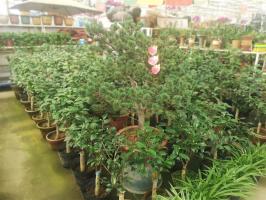How Much Does a Potted Plant Weigh
When it comes to buying a potted plant, one of the most important factors to consider is its weight. The weight of a potted plant can determine how easy or difficult it is to transport and where it can be placed in your home. In this article, we will discuss the factors that can affect the weight of a potted plant and provide some examples of popular indoor plants and their average weight.
Factors That Affect the Weight of a Potted Plant
There are several factors that can contribute to the weight of a potted plant. These include:
The size of the pot: The larger the pot, the heavier the plant will be, especially if the pot is made of a heavy material like ceramic or stone.
The type of soil: Soil can vary in weight depending on its moisture content, texture, and composition. Potting soils that contain perlite or vermiculite may be lighter in weight than soils that contain sand or clay.
The type of plant: Different types of plants have different water requirements and therefore may weigh more or less depending on how much water they have absorbed. Additionally, plants with thicker or denser foliage may be heavier than those with light, airy leaves.
Examples of Indoor Plants and Their Average Weight
Here are some popular indoor plants and their average weight:
Spider plant: This easy-to-care-for plant typically weighs between 2-5 pounds.
Sansevieria (snake plant): A popular plant for its air-purifying properties, the snake plant can weigh between 5-10 pounds.
Peace lily: A low-maintenance plant with beautiful, glossy leaves, the peace lily can weigh between 5-15 pounds.
Fiddle leaf fig: This trendy plant can make a statement in any room, but it can also be quite heavy, weighing between 10-20 pounds.
Monstera deliciosa: Another popular plant with large, showy leaves, the monstera can weigh between 10-20 pounds or more, depending on its size.
Transporting and Maneuvering Potted Plants
If you are purchasing a potted plant from a nursery or garden center, make sure to have a plan for transporting it home. If the plant is particularly heavy or large, it may require a hand truck or dolly to move it. Be sure to protect the leaves and branches during transport to avoid any damage or breakage.
Once you have your potted plant at home, consider its weight when determining where to place it. Heavy plants may need to be situated on the floor or on sturdy, load-bearing furniture. Avoid placing heavy plants on weak or unstable surfaces, like flimsy end tables or bookshelves.
Caring for Potted Plants of Any Weight
Regardless of their weight, potted plants require proper care to thrive. Make sure to water them according to their specific needs and provide them with appropriate sunlight or shade. Regularly check the soil for moisture and adjust your watering schedule as needed. And remember to prune and clean your plant periodically to keep it looking its best.
By understanding the factors that affect a potted plant's weight and considering this when purchasing and placing plants, you can enjoy their beauty and benefits without any unnecessary hassle or damage.

 how many times do yo...
how many times do yo... how many planted tre...
how many planted tre... how many pine trees ...
how many pine trees ... how many pecan trees...
how many pecan trees... how many plants comp...
how many plants comp... how many plants can ...
how many plants can ... how many plants and ...
how many plants and ... how many pepper plan...
how many pepper plan...





























